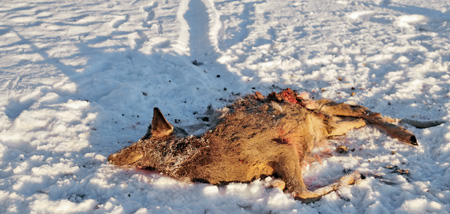
Canis lupus
The Wolf’s body is 100–145 cm long, the tail about 50 cm. The female weighs about 30–35 kg, the male normally 35–45 kg, but may reach 75 kg. The height at the shoulder is approximately 70–80 cm. The fur is yellow-grey, darker on the back, with black areas on shoulders, haunches, and tail. The legs are light, the belly yellowish or grey-white. The winter coat is lighter. On the upper side of the tail, just below the base, there is a black spot.
In its appearance the Wolf resembles a German Shepherd or a large German Spitz, even a Greenland Husky; however, the Wolf has longer legs, and the front feet are closer together. A Wolf’s tracks are therefore not as wide as a domestic dog’s. Normally, the dominant wolves in a pack keep their tails raised, while the others keep theirs lowered.
Wolves are pack animals and often hunt in the dark. Above, LG; below, ME.

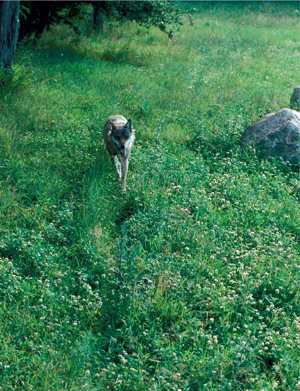
Wolves live in family packs with a dominant male and female and their offspring, but they may also gather in larger packs that patrol clearly demarcated territories, especially in winter. Wolves prefer open terrain with isolated groups of trees rather than dense woodland.
The tracks of a Wolf can resemble those of a large dog or a Lynx; however, Wolf tracks are elongated, while a dog’s are more rounded. Lynx tracks show no claw marks, and the footprints are asymmetric. Wolf tracks may also resemble those of a fox but are much larger. The Wolf has five toes on the front foot, but the innermost toe is located too high to be visible in the prints. The hind foot has only four toes. The front footprints of both Wolves and large domestic dogs are larger, about 9–11 cm long and 8–10 cm wide; the tracks of the hind feet are about 8 cm long and 7 cm wide. The stride is about 90–20 cm; when running, about 120–160 cm.
The toe pads of a Wolf are longer than those of a dog, and the two middle toes are more markedly splayed; the claw marks are also stronger, longer, and more pointed. If one were to draw a straight line between the prints of the two foremost (middle) toes, this line would always cross the prints of the two outer toes (cf. p. 7). With Red Fox, the line will lie behind the prints of the most forward toes and immediately in front of the two hind ones.
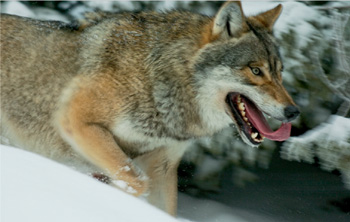
Both Wolf and Red Fox frequently place their hind feet in the prints made by the front, so the tracks form a line that is almost straight. A dog often runs with its body slightly canted, so the prints of the hind feet will lie slightly outside those of the front.
Wolf tracks in deep snow. Below left, ME; right, UR.

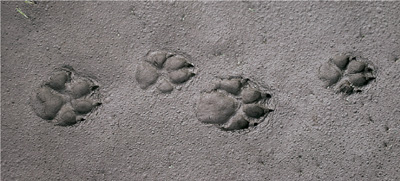
Hind foot of a Wolf. LG.

The tracks of a Wolf often follow a long straight path, while a dog’s prints will inevitably veer left or right when the animal is distracted by an interesting smell or by marking its territory. The Wolf is a heavy animal and sinks deep into fresh snow, which is why several Wolves will follow one another and use the same path—and of course domestic dogs seldom run in a pack.
The scat of a Wolf is the same size as a dog’s and cylindrical in shape, often dark grey, 10–15 cm long, 2.5–3 cm thick, slightly twisted, and often pointed at the ends. When a Wolf has eaten freshly killed prey, the scat can be almost black and soft. It often contains identifiable remains of the prey, while a dog’s scat is not twisted and contains no recognisable remains of its food.
The Wolf defecates at resting places or at the boundaries of its territory, and the scat is clearly visible on stones, stumps, and the like where it has marked its territory; the tracks of the hind feet dragging across the ground may also be visible at these locations. Fresh scat has a markedly musty odor.
The Wolf uses urine to mark the borders of its territory on stones, trees, or other prominent spots. Exactly in the fashion of a domestic dog, the male lifts its leg, while the female urinates in a squatting position.
A Wolf’s den. LG.

A female Wolf marking territory. LG.
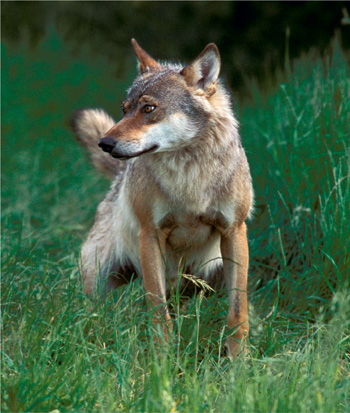
A Wolf’s den has certain characteristics: the entrance is large enough to allow quick entry and exit, and it is usually deep in sandy terrain or between rocks, under tree roots, or in other natural cavities.
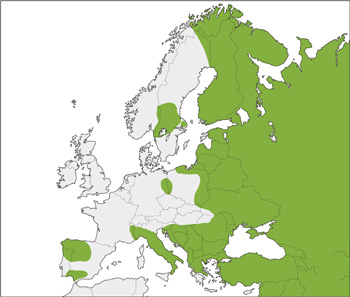
A pack has access to several dens within the home territory, but only one is used when the wolves have cubs. If the pack feels threatened, it moves to another den. Once the cubs are weaned, they join the pack and move around the territory. Wolves often rest in specific locations and flatten the grass by regular use. Wolves readily eat large animals such as Elk or Reindeer, but they also hunt hares, rabbits, European Beavers, and small rodents. You will come across kills throughout a territory and also abundant tracks and scat.
A deer killed by a Wolf. LGA.
